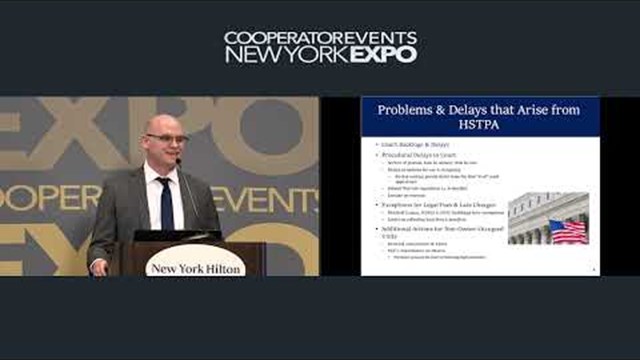Hector and Hedy Johnson bought a new condominium in Queens in 1995 and lived there for 19 years. In 2014 they sold the apartment to Leonard and Lena Smith. A year later, the condominium association’s board of directors voted to replace the building’s roof and imposed a special assessment to pay for the project. “That’s not fair,” the Smiths complained, insisting that they shouldn’t have to pay the full assessment to replace a roof that sheltered the Johnsons for 95 percent of its life.
It wasn’t fair—but major components and systems don’t last forever, and big assessments are what happens when a board doesn’t set aside funds on a regular basis to update those components and systems.
“The number one mistake a board can make is characterizing such things as future expenses,” says Robert Nordlund, founder and CEO of Association Reserves, Inc., a Calabasas, California-based, reserve study firm with clients in every state.
“It’s human nature to worry about future things at a future time,” he explains, “but if you characterize reserve expenses as offsetting ongoing deterioration, the future takes care of itself. Associations that don’t pay this ongoing bill doom themselves to deferred maintenance, special assessments, and declining property values.”
What Deserves Reserves
Nordlund says that for an item to warrant reserve funding, it must be a common area maintenance responsibility, exceed a minimum threshold cost, and have a limited and predictable useful life.
In addition to roofs, long-lived common assets meeting that criteria include masonry walls (which may need concrete restoration or repointing to renew the mortar between bricks); boilers, cooling towers, and other parts of a building’s climate-control system; elevators; the fire-alarm system; interior décor in common areas such as administrative offices, hallways, lobbies, and recreation rooms; sidewalks, streets, parking lots, and garages; balconies and decks; and swimming pool surfaces, pump motors, and filtration systems.
In cooperatives, the building’s underlying mortgage should be a reserve item, too, says Annette Murray, a certified public accountant and a shareholder with Wilkin & Guttenplan, PC, an accounting firm in New York City and East Brunswick, New Jersey.
“The board needs to monitor and plan for a mortgage, especially when it’s coming up to be refinanced a couple of years ahead,” she says. “Many co-ops pay interest only and just keep refinancing the same dollar amount. If they need more money, they increase their mortgage. A best practice would be to have a mortgage that amortizes, paying interest and principal.”
Why Not New York?
In most jurisdictions, common-interest associations conduct a reserve study—a budgeting tool that assigns an approximate useful life to each major building component, estimates its replacement cost, and sets aside funds each year so replacement funds will be adequate when replacement time comes.
Associations update their reserve study annually or every few years to account for inflation and product enhancements. “Reserve studies should prepare the association for material and technical upgrades such as new pool surfaces and more efficient elevators and boilers. You buy the new appropriate thing, not a like-for-like replacement,” Nordlund says.
Many states require reserves, and some even specify the minimum acceptable percentage of the budget that an association must set aside in reserve. However, in some markets - New York City being one major example - no such requirement exists, and consequently many associations do nothing. “Others perform a capital-needs assessment, which states what will need replacement within the next five or six years and how much that will cost, but doesn’t set up a funding plan,” says Mitchell H. Frumkin, president of Kipcon Inc., a full-service engineering firm based in North Brunswick, New Jersey. He served in 2002 as president of the Community Associations Institute (CAI), a national membership organization for common-interest residential communities. “It just assumes that the board has money, which may come from savings, a special assessment, or a loan.”
“In the past,” Frumkin explains, “board attorneys have recommended that their clients not do reserve studies because they would be liable if they guess wrong [about replacement timetables or costs]—but the truth is, boards have more liability if they don’t do a study.”
Attorneys’ opinions notwithstanding, many boards are beginning to embrace reserve studies to make people buying into their buildings eligible for Federal Housing Administration (FHA) financing. To qualify a building, “its board must set aside 10 percent of the budget as a reserve, or present a reserve study less than two years old that states what should be set aside,” Frumkin says.
A typical reserve study set-aside increases the annual budget by a half percent to one percent, Nordlund says. Thus, buildings that rely on the FHA reserve percentage requirement will collect significant excess reserves, while their owners pay monthly assessments well above the funding needs of an individual reserve study for their building.
The Right Team
A reserve study that yields useful information should be a team effort, beginning with the board and its property manager or management firm. “The manager is the primary communicator between the board and its vendors,” says Matthew Grobert, vice president-capital reserves and transitions specialist for The Falcon Group, an engineering firm based in Bridgewater, New Jersey.
“Every association should have a good attorney well-versed in common-community law,” he continues, and because the laws specific to condos, co-ops, and homeowners’ associations vary to some extent, the attorney should have an especially strong background in the type of community the board oversees.
In selecting a professional to perform the reserve study, a board should employ an engineer who is a reserve specialist (RS) and/or a professional reserve analyst (PRA). A board’s own in-house engineer may help with specific property knowledge, but probably won’t have the expertise of a consultant with reserve credentials.
CAI administers the RS designation. The PRA credential comes from the Association of Professional Reserve Analysts, the reserve-study industry’s own trade organization. Grobert is a reserve specialist; Frumkin and Nordlund hold both credentials as well.
However, “Some firms doing reserve studies don’t even have a professional engineer on their staff,” Grobert cautions. “They use some other way to gather costs.”
One such secondary source is RSMeans, a large company that compiles and publishes construction-cost data for estimating purposes. “It’s accurate, but not as accurate as actually overseeing the work,” Grobert says. “Using a firm with architects and engineers doing replacements and restorations helps me to perform a very accurate reserve study, because I have up-to-date costs.”
Tolerance Level
Once the reserve study is complete, the board and owners must decide on a funding plan based on their tolerance for risk and their willingness to set money aside each month for the reserves.
Some associations strive for full funding, collecting enough money to replace each component at the end of its useful life, without charging residents any additional assessments. In the interim, the stored funds yield interest and serve as an inflation hedge. This sounds good, but many owners disapprove of a fully-funding approach because it increases their monthly assessments.
At the opposite extreme is baseline funding, which reduces annual contributions, eventually dropping the reserves to zero. This strategy lowers the monthly assessments, “But if a component has to be replaced early, or costs more than expected, you can run into trouble,” Frumkin warns.
Threshold funding strikes a middle ground between full and baseline funding. “Most associations do threshold,” Frumkin says. “They’re maybe 60 percent to 70 percent funded,” and if a big repair or replacement is needed, the budgetary shortfall will be made up with a one-time assessment of all residents.
Where the Money Goes
The building’s accountant and banker or financial advisor should be part of the reserve-study team to help the board decide where to invest the reserves until they are needed. The accountant’s main role is to sort out these capital contributions (which are not taxable and can be carried forward from year to year) from taxable interest on investments.
Whatever investments are selected must be extremely safe, enabling the board to fulfill its fiduciary responsibility, says Abdullah Fersen, chief executive officer of Newgent Property Management in Yonkers, New York. His company manages 38 buildings all over New York City, ranging in size from 16 to 120 units and in age from 30 to 70 years. Fersen says acceptable investments include certificates of deposit, money-market funds, and U.S. Treasury securities—bills, notes, and bonds—with varying degrees of maturity.
“When you set up your investments, make sure they’re laddered,” Frumkin advises. “Don’t put it all into long-term investments. Look at the reserve study and plan, so your investments come due when they’re needed, and so you don’t run into penalties when you have to spend money to replace something.”
How Insurance Fits In
Although insurance deals with loss prevention due to accidental occurrences, not predictable deterioration, the board’s insurance adviser has a role to play in the reserve study. He or she can help the board weigh its risk tolerance against its insurance costs, deciding what perils to cover and to what extent. Properly made, this judgment can help a board recover from a disaster without exhausting its reserves.
Grobert recalls a major hailstorm that struck a private 52-unit Colonial-style community in northern New Jersey about 10 years ago. Built in the 1970s, the community’s historically correct exteriors look more than two centuries older. During the storm, hailstones the size of tennis balls broke windows and light fixtures, destroyed cedar shake roofs, and damaged cedar clapboard siding, causing $3.5 million in damage.
The community’s property manager contacted its insurance company. Adjusters visited. A claim was filed, processed, and approved. Then the homeowners’ association hired Grobert’s company to write engineering specifications and oversee the remedial work. Based on those specifications, the association hired a contractor to perform the work.
The insurance proceeds covered most of the repairs. “The association had to borrow a small amount of money,” he says. “They included it in their capital reserve account, with a special assessment for five years to pay off the loan.”
George Leposky is a freelance writer and editor living in Miami, Florida, and is a frequent contributor to The Cooperator.
To learn more about reserve studies, see Reserve Funds: How & Why Community Associations Invest Assets, published by CAI Press, Falls Church, VA, in 2009 and 2013. A new edition is due to appear in late 2016.







Comments
Leave a Comment